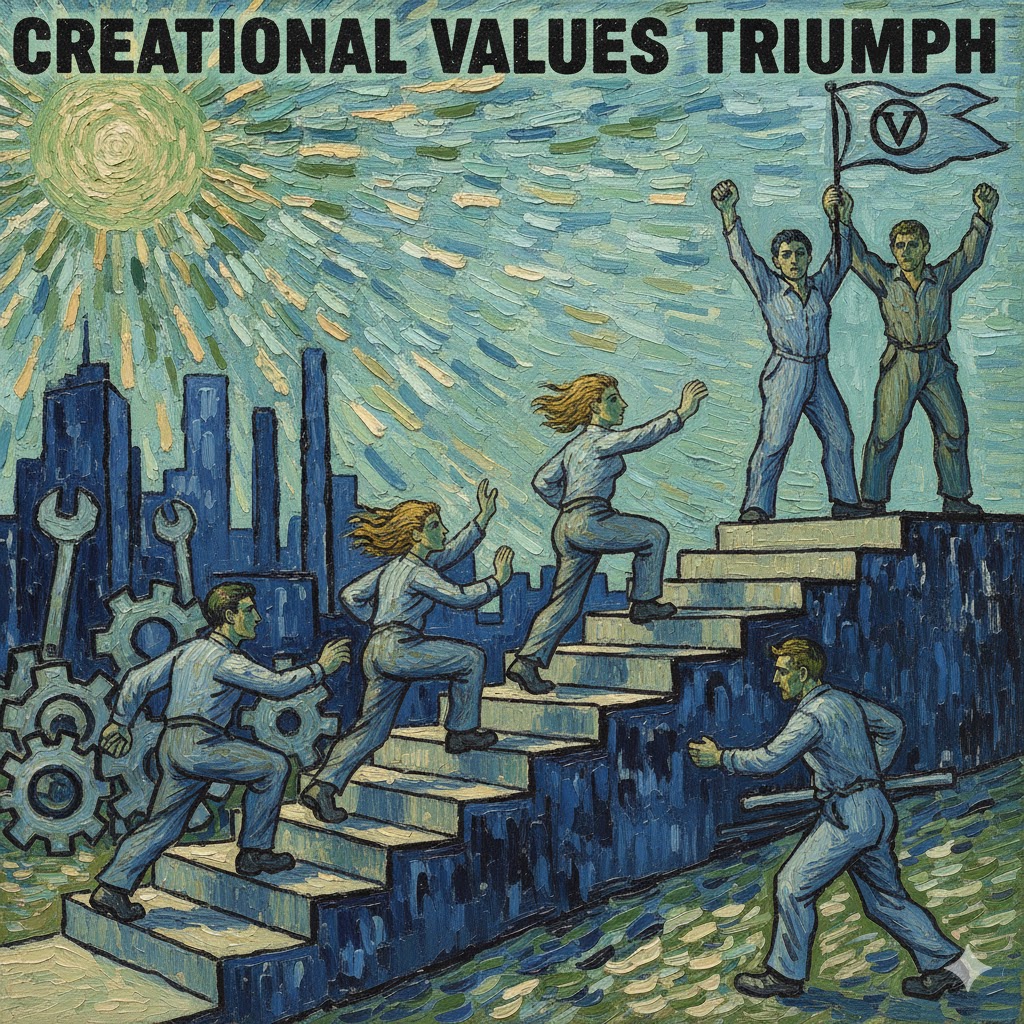
Activating Purpose: How the Three Levels of Values Drive SOPs
Transforming routine Standard Operating Procedures into meaningful, high-performance Creational Values, based on Randal Weidenaar’s VP Culture framework.
To achieve profound organizational alignment and harness the **quantitative performance gains** seen in values-driven organizations, leaders must connect their high-level mission to the daily execution of tasks. Randal Weidenaar’s research at VP Culture offers a structured, three-tiered model of values that provides the exact linkage needed to transform routine **Standard Operating Procedures (SOPs)** into meaningful **Creational Values**.
This model provides the philosophical foundation for the formal **Values Curriculum** necessary to sustain the neural and behavioral alignment explored in Falk’s work.
The VP Culture Framework: Three Levels of Values
Randal Weidenaar’s research, rooted in behavioral and organizational psychology, posits that values are not chosen, but rather discoverable and universally structured in three hierarchical tiers that must all be connected for true motivation:
- Ultimate Values (The Universal Why): The single, deepest, unifying value that motivates all human beings. Weidenaar identifies this as Valuing People. When an organization places people—employees, customers, and stakeholders—at the core, it taps into the fundamental human drive.
- The Mandate: Without this ultimate value as the “operating system,” 70% of individuals go through work without the necessary energy and motivation.
- Experiential Values (The Relational Keys): The six specific values that act as the keys to creating and sustaining thriving teams and personal well-being (e.g., trust, respect, honesty, etc.). These values shape the relational interactions at work.
- The Mechanism: Focusing on these relational values fosters the release of neurochemicals like serotonin and oxytocin, which upregulate DNA expression and enhance the prefrontal cortex—the very brain region responsible for IQ, ethics, creativity, and executive function.
- Creational Values (The Daily How): These are the day-to-day, observable actions, behaviors, and routines—the **SOPs**—that physically and tangibly deliver the experiential values. This is where the abstract meets the concrete.
Connecting Creational Values (SOPs) to Ultimate Purpose
The three-level values model provides the critical missing link by defining the purpose of every action:
| Value Level | Description | Example (A Customer Service SOP) |
|---|---|---|
| 1. Ultimate Value | Valuing People. The highest, most universal purpose. | Goal: To ensure every customer feels uniquely valued as a person. |
| 2. Experiential Value | Respect (one of the six keys). The desired feeling/experience. | Goal: To ensure the customer feels they were truly heard and their time was respected. |
| 3. Creational Value (SOP) | The Specific Action. The daily routine. | SOP: “Before offering a solution, the agent must repeat the customer’s problem back to them using their own words and wait for verbal confirmation.” |
In this model, the SOP is no longer a rote task; it becomes a sacred, meaningful act—a **Creational Value**—that intentionally manifests the Experiential Value of Respect, thereby fulfilling the Ultimate Value of Valuing People.
Using Data to Support the Thesis
| Neuroscientific Principle (Falk/Weidenaar) | Quantitative Result (VP Culture/HBR) | Implementation Strategy (Values Curriculum) |
|---|---|---|
|
Overcoming Defensiveness: Falk’s research shows values affirmation activates the VMPFC to increase receptivity to challenging messages. |
Financial Uplift: Prioritizing the Ultimate Value of Valuing People leads to an average 11% higher stock value. |
Focus on the “Why”: Train leaders to preface all SOP changes with an explanation of *how* the change serves the Ultimate Value of **Valuing People**, reducing employee defensiveness and increasing VMPFC-driven receptivity. |
|
Enhancing Executive Function: A lack of valuing triggers stress (cortisol) that impairs the **Prefrontal Cortex** (IQ, creativity). |
Productivity & Profit: High-engagement organizations (built on **Experiential Values**) experience a 21% increase in profitability and higher efficiency (HBR-cited data). |
Values-Driven SOP Design: Mandate that teams review SOPs to ensure every step is intentionally designed to elevate the six **Experiential Values**, lowering stress and restoring optimal Prefrontal Cortex function. |
|
Sustained Motivation: Falk notes the brain’s bias for **immediate reward** over long-term values. |
Sustained Alignment: VP Culture emphasizes the need for a **”living, breathing curriculum”** and continuous development. |
Values Mastery Curriculum: Formalize a curriculum where leaders and teams perform **Creational Value Audits**. This ritual of reviewing SOPs against the ultimate purpose ensures **Creational Values** remain the neurological path of least resistance for sustained alignment. |
By consciously linking the daily grind (**SOPs/Creational Values**) to the shared human purpose (**Ultimate Value**), leaders provide the meaning that fuels intrinsic motivation, turning procedural compliance into inspired commitment.